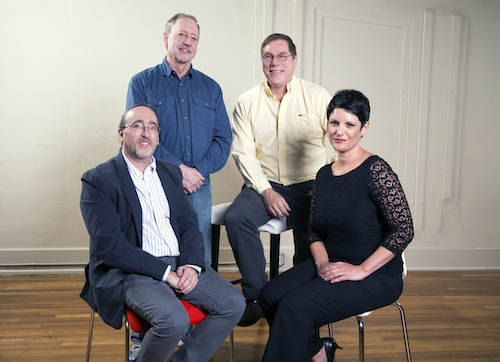The College’s four newest departmental leaders discuss their jobs, our campus culture, and the opportunities they see at UAB.
Photos by Nik Layman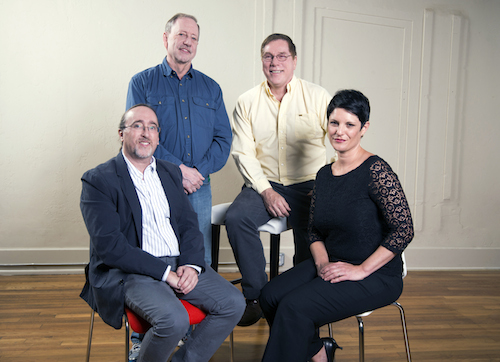 Dr. David Pollio, Dr. Steve Austad, Dr. Douglas Fry, and Prof. Lauren Lake.While Prof. Lauren Lake, Dr. Steve Austad, Dr. Douglas Fry, and Dr. David Pollio all work in very different fields, they share a common role in the College of Arts and Sciences as the newest chairs of their respective departments. We asked the four of them to sit down and discuss their careers, their decision to come to UAB, and the future they envision.
Dr. David Pollio, Dr. Steve Austad, Dr. Douglas Fry, and Prof. Lauren Lake.While Prof. Lauren Lake, Dr. Steve Austad, Dr. Douglas Fry, and Dr. David Pollio all work in very different fields, they share a common role in the College of Arts and Sciences as the newest chairs of their respective departments. We asked the four of them to sit down and discuss their careers, their decision to come to UAB, and the future they envision.Julie Keith: Thank you all for being willing to take some time out of your busy schedules to talk. Let’s just start with what got you here. What about UAB appealed to you, and why did you decide to come here to lead your department?
Steve Austad: Well, to be honest with you, I had a competing offer of a different nature at the same time I had the opportunity to come here to UAB. The appeal to me was that at UAB I saw the potential to grow and improve something. The prospect of playing a role in that was very exciting to me.
Lauren Lake: Same exact reason.
David Pollio: In conversations I’ve had, I think a lot of us are really caught up in the vision of where the College is going. I’ve never been in a department in a large college before. I am intrigued by the vision of really working in all of these different disciplines.
LL: I would add that I was drawn to the urban context of an art school. The arts and culture in Birmingham really complement that. I’m coming from a College of Fine Arts into a College of Arts and Sciences—it’s refreshing to have colleagues across disciplines.
SA: I love that. I missed that. Before I came here I was at a standalone medical institution, and I missed having scholarship. At a medical institution, it’s all about research and grant dollars. I love having people from history, anthropology, and social work to talk to. It enriches my life.
DP: My head spins at times at how we could do things that are really interesting and innovative. This kind of opportunity is rare in academia. I also think what made this a place I wanted to come to is the leadership. I think we have to mention the leadership.
[Everyone agrees.]
DP: One of the things that has been frustrating to me over time is leadership that accepts the status quo, and from what I’m hearing we all got the same message: Come in, grow, be creative, be innovative. I think a culture of innovation has to be supported by administration that is willing to take some risks and make some statements. I think if you listen, all four of us have said something about not doing business as usual. The recruitment has shown that they are looking for people who are doing something different.
Doug Fry: And who will work together doing it.
LL: I think the Dean sees not only the big picture but the road ahead, and he’s been very supportive and strategic in the moves he’s made. And there’s an expectation that you too will be very supportive and strategic. It’s great when you can make an impact on a community or a city with your work. There’s an expectation and a desire for everyone to make this place something special. It’s really about getting on the ground, doing the hard work, getting your infrastructures in line (and there is a lot of support for that), so you can do your work.
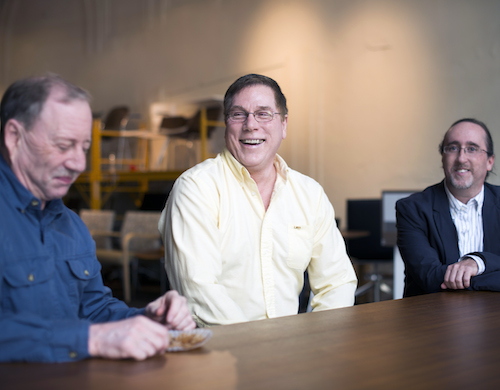 Doug FryDF: It was a lot of work to set up my program in Finland. Even with the support of the Finnish President, who was also a former Nobel Laureate in Peace, the administration still said no. I get a totally different feeling here at UAB. Even after a couple of months I feel so much support, particularly from Dean Palazzo.
Doug FryDF: It was a lot of work to set up my program in Finland. Even with the support of the Finnish President, who was also a former Nobel Laureate in Peace, the administration still said no. I get a totally different feeling here at UAB. Even after a couple of months I feel so much support, particularly from Dean Palazzo.SA: He’s the reason I’m here. I wouldn’t be here without him.
DP: Absolutely.
JK: How do you see the College integrating with the medical side of campus? There’s this natural dichotomy that we have. Do you see that being a challenge? Or an opportunity?
SA: I spend more of my time on the medical end of campus than on this end, because I think the dichotomy is an artificial one. And I think there are people on the medical side who are interested in History and Art. I think they have felt as isolated from us as we have from them. I think one of the exciting things is the merging of these two sides, on a personal level. I have to say I jumped right into this and I’m teaching in the fall one of these interdisciplinary honors courses. [Looks to Doug.] If you had been here you’d have been in on this one, I’m sure..It’s called War and Peace: Conflict and Cooperation.
Doug Fry: Yes, Mike [Sloane] asked me to give a couple of lectures.
SA: Good! Suddenly I have the opportunity to teach a class that has a psychologist, someone from the Department of Government, an English professor, someone from Justice Sciences…me. That’s what universities are all about. I just love it.
DP: It’s kind of funny being the only professional discipline in the College. Social Work is unique. But it also means we closely connect to Public Health and Medicine. We connect to the VA. Moving down the road from Tuscaloosa, which doesn’t have all of this richness, has been one of the most exciting things. I think it’s an incredibly rich set of opportunities.
DF: One of the things that has appealed to me is the new Institute for Human Rights starting up (see page 10). People from various fields will participate in different ways and will be working together. That’s also, jumping back to your previous question, that’s one thing that really appealed to me about coming to UAB. I already saw in the strategic plan that there was mention of an Institute for Human Rights as well as what I saw as a lot of sensible, right-thinking values, which appealed to me coming out of a peace program.
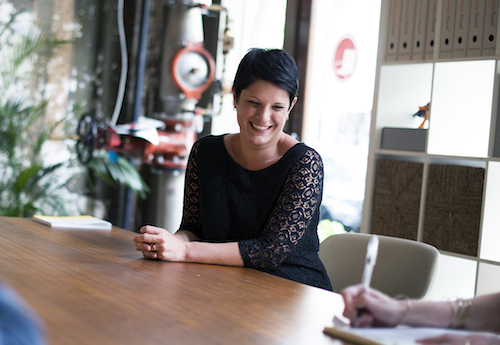 Lauren LakeLL: I agree. When Kay [Dr. Kathryn Morgan] presented [at the chair’s leadership retreat] on the African American Studies Program, it was easy to see how the Department of Art and Art History could fit into many new programs. Like Engineering and CIS wanting to work with us on 3D modeling and fabrication laboratories. For us, art doesn’t exist without context, so our students and faculty should be thriving in this environment.
Lauren LakeLL: I agree. When Kay [Dr. Kathryn Morgan] presented [at the chair’s leadership retreat] on the African American Studies Program, it was easy to see how the Department of Art and Art History could fit into many new programs. Like Engineering and CIS wanting to work with us on 3D modeling and fabrication laboratories. For us, art doesn’t exist without context, so our students and faculty should be thriving in this environment.JK:How does this trickle down to students? What are the ways you can see students benefiting in visible ways from these interdisciplinary projects in the next year or so?
SA: We’re going to review our curriculum, and one of the things we’re going to make sure is that students aren’t so overloaded with biology and science questions that they don’t have the opportunity to graduate with a more well-rounded education. That would be catastrophic, to have your students graduate without taking advantage of all these opportunities. [Looks at Lauren.] I mean, I was delighted to discover that we shared a student in Art and Biology last year. That was wonderful to see.
LL: Yes. We’re also reviewing our curriculum. Through our visiting artists and scholars, through exhibitions and programs collaborating through AEIVA galleries we’re trying to create more opportunities for students. It never was disconnected, it always has been connected, but now through the framework of the college leadership we’re able to contextualize it for everyone else. For us there is no divide.
DP: We’re looking at what happens to students who are in online versus physical classrooms, trying to look at the concept of community. One of the challenges in the immediate future, as we look online and move out of the traditional academy, is how do we not lose that experience where teachers and students got together and talked and learned from each other. How do we keep education about all of the other things in the midst of this move to individualized online instruction? What makes a university, including a fine public one like this one, a viable part of the future of education?
LL: I don’t want to leave out that there is a service component to what we do, just naturally. Across departments many of our faculty and students are involved in transforming this community and others across the world, really as just doing what we do. I think that’s really exciting and I think it is a great place to situate that kind of work.
SA: That makes me very proud to be here, to see that kind of thing going on.
JK:Is that unique in your experience?
SA: Yes. Well, it’s kind of a unique situation where you have a decent-sized city with an urban campus and a real goal of the university to integrate with the community. Again, the opportunities here are just unbelievable.
JK:What are some of the challenges you see?
LL: People don’t know how really great UAB is.
 David PollioDP: It’s funny, in Medicine and Public Health, going from Tuscaloosa to Birmingham, everyone said, “Oh my God, that’s a huge step forward, you’re going to a national- or international-level institution.”
David PollioDP: It’s funny, in Medicine and Public Health, going from Tuscaloosa to Birmingham, everyone said, “Oh my God, that’s a huge step forward, you’re going to a national- or international-level institution.”DF: I think it’s going to be a challenge to take what are four fields in anthropology: archaeology, cultural anthropology, biological anthropology and linguistic anthropology, and transform that to some degree to a specialized focus along these areas of peace and conflict studies. It’s an opportunity and a challenge at the same time. How do we make that transition?
LL: It’s just within the department. If I have a student who is interested in peace studies and visual arts then those connections are easy for the students in a college like this, and those are the students who we should be attracting and who we can foster while they are here.
JK:How do you translate all of this to potential students? How do you explain all of this opportunity and interconnectivity to a high school student?
LL: No one’s told the story well yet.
DP: It’s an integrated story. People will come for it. [Turns to Doug.] They’ll come for peace studies, I know I would.
LL: Yes.
DP: It’s telling the story of the dynamic College.
LL: It’s a big challenge, nationally and internationally. What is higher ed? I think that’s probably part of your question. The College has this amazing opportunity to draw students who will be the game changers.
DP: It’s a funny conflict. We need to attract the talented students but we need to also attract students we would not normally look at. It’s looking at the people who will become the best and the brightest.
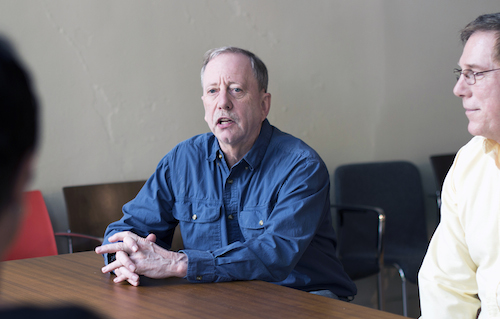 Steven AustadSA: You can do this with your admissions policy. But I also think that the challenge once you do that is that you may admit people who discover it’s not the right place for them. You’re going to have to deal with that.
Steven AustadSA: You can do this with your admissions policy. But I also think that the challenge once you do that is that you may admit people who discover it’s not the right place for them. You’re going to have to deal with that.DP: A major challenge for an institution in a city and state that has so much poverty and disparity is how to use education and admission as a portal to growing the community. This is the intervention that will make a difference.
SA: It’s one of the things that all of the departments do, to go out in the community and talk to K-12 classes and make it reasonable for kids to think, “I can really do this.” That’s what I like about all the community outreach. It’s an attitude. Nobody’s told me specifically your department needs to do this. Everyone in my department is already doing it.
LL: It’s different here, more grassroots. That applies to collaboration here, too. It’s just naturally occurring.
SA: It’s part of the ethos.
